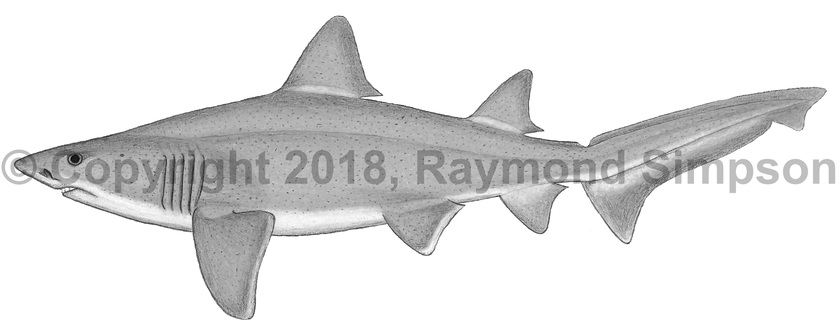
Common Name
Raggedtooth Shark
Year Described
Risso, 1810
Identification
Teeth rows: 46-56 upper, 36-48 lower
Body heavy and robust. Head and snout relatively deep with a large mouth with prominent teeth easily visible when mouth is closed. Snout relatively long and conical. Teeth long and thin with 2-3 lateral cusplets. Post-oral grooves absent. Eye relatively large. Gill slits large with last two slightly closer together at pectoral origin. First dorsal fin placed well back on body (over rear tip of pectoral fin) and triangular. Second dorsal fin half the size of D1. Pelvic and anal fins also placed far back on body, with anal fin being distinctly smaller than pelvic fin and about the same size as D2. Pelvic fin closer to D2 than D1. Anal fin origin under rear of D2. Pectoral fin large and somewhat falcate. Caudal fin with a strong upper and lower lobes. Subterminal notch strong. Precaudal pit only present dorsally. No lateral or peduncular keels. Skin rough.
Color
Body uniformly gray with a whitish to gray belly. Appears unmarked from a distance but often has many small faint darker slots and blotches. Fins body colored with no markings. Eye black.
Size
Maximum size to over 400cm TL. Mature adults from 200-350cm TL with females averaging much larger. Newborns over 100cm TL.
Habitat
Found in relatively deep water in some areas but shallower waters elsewhere (10-1015m). Can be found in midwater but much more common around the bottom (both hard and soft).
Range
Scattered records from the region: off the U.S. southeast coast, the Yucatan Peninsula, the Bahamas, Colombia, Venezuela and Brazil. Likely more widespread but rarely captured.
References
Castro, J.I. 2011. The Sharks of North America. Oxford University Press, 640 pp.
Ebert, D. A., & M. Dando. 2020. Field Guide to Sharks, Rays & Chimaeras of Europe and the Mediterranean. Princeton University Press. 2020.
Tavares, R., Sanchez, L. & J.M. Briceño. 2019. First record of the ragged-tooth shark, Odontaspis ferox (Risso, 1810), in the Venezuelan Caribbean. Marine Biodiversity Records, 12(1), 1-5.
Other Notes
Easy to distinguish from Carcharias taurus by plain coloration, snout shape, relative fin position and size, tooth morphology, and habitat.